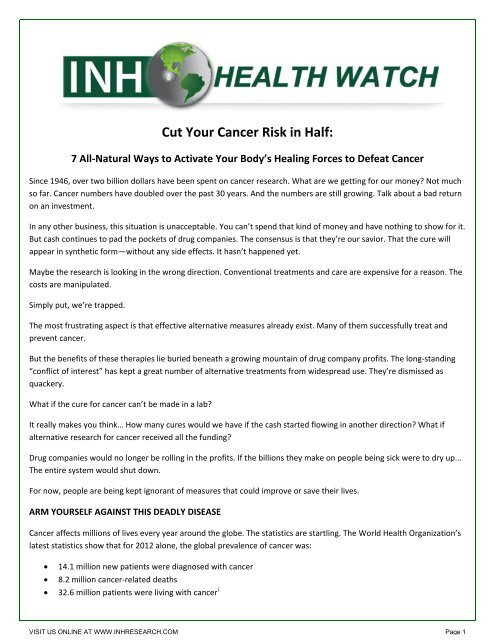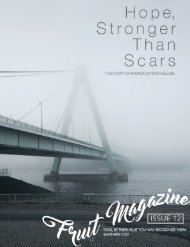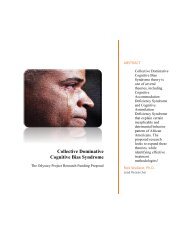Cut Your Cancer Risk in Half:
You also want an ePaper? Increase the reach of your titles
YUMPU automatically turns print PDFs into web optimized ePapers that Google loves.
<strong>Cut</strong> <strong>Your</strong> <strong>Cancer</strong> <strong>Risk</strong> <strong>in</strong> <strong>Half</strong>:<br />
7 All‐Natural Ways to Activate <strong>Your</strong> Body’s Heal<strong>in</strong>g Forces to Defeat <strong>Cancer</strong><br />
S<strong>in</strong>ce 1946, over two billion dollars have been spent on cancer research. What are we gett<strong>in</strong>g for our money? Not much<br />
so far. <strong>Cancer</strong> numbers have doubled over the past 30 years. And the numbers are still grow<strong>in</strong>g. Talk about a bad return<br />
on an <strong>in</strong>vestment.<br />
In any other bus<strong>in</strong>ess, this situation is unacceptable. You can’t spend that k<strong>in</strong>d of money and have noth<strong>in</strong>g to show for it.<br />
But cash cont<strong>in</strong>ues to pad the pockets of drug companies. The consensus is that they’re our savior. That the cure will<br />
appear <strong>in</strong> synthetic form—without any side effects. It hasn’t happened yet.<br />
Maybe the research is look<strong>in</strong>g <strong>in</strong> the wrong direction. Conventional treatments and care are expensive for a reason. The<br />
costs are manipulated.<br />
Simply put, we’re trapped.<br />
The most frustrat<strong>in</strong>g aspect is that effective alternative measures already exist. Many of them successfully treat and<br />
prevent cancer.<br />
But the benefits of these therapies lie buried beneath a grow<strong>in</strong>g mounta<strong>in</strong> of drug company profits. The long‐stand<strong>in</strong>g<br />
“conflict of <strong>in</strong>terest” has kept a great number of alternative treatments from widespread use. They’re dismissed as<br />
quackery.<br />
What if the cure for cancer can’t be made <strong>in</strong> a lab?<br />
It really makes you th<strong>in</strong>k… How many cures would we have if the cash started flow<strong>in</strong>g <strong>in</strong> another direction? What if<br />
alternative research for cancer received all the fund<strong>in</strong>g?<br />
Drug companies would no longer be roll<strong>in</strong>g <strong>in</strong> the profits. If the billions they make on people be<strong>in</strong>g sick were to dry up...<br />
The entire system would shut down.<br />
For now, people are be<strong>in</strong>g kept ignorant of measures that could improve or save their lives.<br />
ARM YOURSELF AGAINST THIS DEADLY DISEASE<br />
<strong>Cancer</strong> affects millions of lives every year around the globe. The statistics are startl<strong>in</strong>g. The World Health Organization’s<br />
latest statistics show that for 2012 alone, the global prevalence of cancer was:<br />
<br />
<br />
<br />
14.1 million new patients were diagnosed with cancer<br />
8.2 million cancer‐related deaths<br />
32.6 million patients were liv<strong>in</strong>g with cancer i<br />
VISIT US ONLINE AT WWW.INHRESEARCH.COM Page 1
In large part, this dire prediction is based on the ag<strong>in</strong>g global population. The older you are, the higher your risk of<br />
develop<strong>in</strong>g cancer. Costs are sure to be through the roof. There are doubts our current system could even handle it.<br />
We’ve seen what happens <strong>in</strong> the past when we “trust the system.” The stock market crashed out of nowhere.<br />
Conventional medic<strong>in</strong>e is a profit‐driven <strong>in</strong>dustry no different from a Wall Street <strong>in</strong>vestment company.<br />
You need to know that you have options that exist beyond ma<strong>in</strong>stream medic<strong>in</strong>e and Big Pharma. Don’t use the onesize‐fits‐all<br />
model that currently exists. You can select a treatment that works for you.<br />
In this report, we’ll look at cancer from several perspectives:<br />
<br />
<br />
<br />
<br />
How cancer forms <strong>in</strong> the human body<br />
Conventional treatment and the effects on the body<br />
Real, “alternative” treatments to consider us<strong>in</strong>g for cancer treatment<br />
Preventive measures to create a cancer‐resistant environment <strong>in</strong> your body—and cut your risk of develop<strong>in</strong>g<br />
cancer by up to 50 percent<br />
WHY PEOPLE GET CANCER<br />
<strong>Cancer</strong> can develop <strong>in</strong> any cell tissue <strong>in</strong> the body. Each cell has a built‐<strong>in</strong> brak<strong>in</strong>g system to regulate growth. If that<br />
system fails, the cell becomes a runaway tra<strong>in</strong> of unregulated growth. These aberrant cells cont<strong>in</strong>ue to grow. They divide<br />
and multiply until they become their own tissue cluster that spreads throughout the body.<br />
Development of cancer beg<strong>in</strong>s with the <strong>in</strong>itiation phase. The cell’s genetic materials go through a change that sets the<br />
stage for them to turn cancerous. These changes are the work of some external agent. It could be:<br />
<br />
<br />
<br />
Chemical exposure<br />
Virus<br />
Radiation<br />
Not every cell is equally susceptible to these agents. Otherwise, every cell <strong>in</strong> your body would turn cancerous. The cell<br />
itself may have an exist<strong>in</strong>g flaw. That would make it more likely to change.<br />
After <strong>in</strong>itiation is the promotion phase. The DNA undergoes changes and the cell becomes cancerous.<br />
There are three lead<strong>in</strong>g reasons why people get cancer. <strong>Your</strong> tipp<strong>in</strong>g po<strong>in</strong>t could be different than your neighbor. It<br />
could be one or more of the follow<strong>in</strong>g factors:<br />
<br />
<br />
<br />
A weak immune system perform<strong>in</strong>g at sub‐optimum levels<br />
Hav<strong>in</strong>g a poor diet or be<strong>in</strong>g <strong>in</strong> a chronic state of malnutrition<br />
Poor lifestyle choices that create toxic load with<strong>in</strong> the body<br />
Let’s take a closer look how these contribute to a cancer‐friendly environment.<br />
Immune System<br />
A healthy immune system won’t guarantee that you stay cancer‐free. But it’s more likely that cancer will develop if your<br />
immune system isn’t function<strong>in</strong>g at its best. <strong>Cancer</strong> is 100 times more likely to occur <strong>in</strong> people who are on immune<br />
system‐suppress<strong>in</strong>g drugs. ii<br />
VISIT US ONLINE AT WWW.INHRESEARCH.COM Page 2
The immune system defends the body by attack<strong>in</strong>g and clean<strong>in</strong>g out cancer cells. That activates white blood cells to do<br />
their job. Once a cancerous cell forms, it creates a new antigen on its surface. The immune system doesn’t recognize it.<br />
It kicks <strong>in</strong>to response mode to wipe out the threat.<br />
Even a strong immune system struggles with this task. Imag<strong>in</strong>e if it’s already weakened. The challenge to sweep out<br />
cancerous cells is that much more difficult. The immune system wears down for a variety of reasons. They <strong>in</strong>clude high<br />
levels of stress, exist<strong>in</strong>g illness or disease, poor diet, and lack of sleep.<br />
Diet/Nutrition<br />
A poor diet paves the way for cell mutations. This leaves the door open for cancer cells to form. A healthy diet, on the<br />
other hand, supports the immune system.<br />
The support comes <strong>in</strong> the form of nutrients. If the diet isn’t supply<strong>in</strong>g those nutrients, the body struggles to work<br />
properly. Each system with<strong>in</strong> the body fights to get a share of what’s available. It’s like a massive budget cut. Everyone<br />
gets fewer resources but must produce the same results.<br />
If your system is already under attack by cancer, it needs way more support than usual.<br />
A diet rich <strong>in</strong> nutrient‐deficient foods can erode your health over time. About one third of the 500,000 annual cancer<br />
deaths can be partially attributed to diet.<br />
The American <strong>Cancer</strong> Society promotes eat<strong>in</strong>g a “healthy” diet. But we’ll show you later why their idea of a “healthy<br />
diet” misses the mark.<br />
Lifestyle<br />
Smok<strong>in</strong>g is one of the lifestyle behaviors that cause cellular changes that lead to cancer.<br />
Another risk factor is physical <strong>in</strong>activity. Accord<strong>in</strong>g to the American <strong>Cancer</strong> Society, it ranks alongside diet as a lead<strong>in</strong>g<br />
cause. Be<strong>in</strong>g physically active reduces your risk for develop<strong>in</strong>g a variety of cancers. This <strong>in</strong>cludes breast and colon<br />
cancers.<br />
Exercise negates the effects of other cancer risk factors. It’s important to ma<strong>in</strong>ta<strong>in</strong> a healthy body weight. Improv<strong>in</strong>g<br />
digestive and elim<strong>in</strong>ation processes make your body work better. Regulat<strong>in</strong>g hormones and <strong>in</strong>sul<strong>in</strong> will also help keep<br />
cancer away.<br />
THE DREADED DIAGNOSIS<br />
<strong>Cancer</strong> screen<strong>in</strong>g tests exist to f<strong>in</strong>d pre‐cancerous or cancerous cells before symptoms beg<strong>in</strong> to appear. A positive test<br />
result requires more <strong>in</strong>vasive test<strong>in</strong>g, like a biopsy.<br />
After a diagnosis comes a stag<strong>in</strong>g test. This determ<strong>in</strong>es where the cancer is and if it has spread beyond the <strong>in</strong>itial site. It<br />
then gets assigned a stage <strong>in</strong> reference to its degree of severity. That determ<strong>in</strong>es any possible course of treatment and<br />
overall prognosis.<br />
There are five stages of cancer. Stage 0, or carc<strong>in</strong>oma <strong>in</strong> situ, serves as a basel<strong>in</strong>e for cancer that hasn’t spread beyond<br />
the <strong>in</strong>itial layer of cells where it started.<br />
Stages I, II, and III classify the extent of the cancer. This <strong>in</strong>cludes the size of the tumor and whether or not the cancer has<br />
spread. The higher the number, the more severe the cancer. Stage IV cancer has moved <strong>in</strong>to other organs or spread <strong>in</strong>to<br />
other areas of the body.<br />
VISIT US ONLINE AT WWW.INHRESEARCH.COM Page 3
After diagnosis, most will bl<strong>in</strong>dly follow the advice of their doctors and opt to beg<strong>in</strong> traditional treatment.<br />
THE TRIFECTA OF TRADITIONAL TREATMENT<br />
Conventional medic<strong>in</strong>e has a very limited menu: surgery, chemotherapy drugs, and radiation. But these standards of<br />
treatment are often <strong>in</strong>effective. They are toxic to your body—even outright deadly. Yet <strong>in</strong>stead of a last resort, they’re<br />
at the frontl<strong>in</strong>e of the battle.<br />
Surgery<br />
It’s an <strong>in</strong>vasive procedure that further diagnoses the extent of the cancer. It also attempts to cut cancerous cells out<br />
completely. But there’s a huge risk that comes with surgery. If a tumor is cut out, cancerous cells can escape <strong>in</strong>to the<br />
bloodstream. It could cause the cancer to spread further. To add <strong>in</strong>sult to <strong>in</strong>jury, surgery is outrageously expensive.<br />
Chemotherapy<br />
A comb<strong>in</strong>ation of drugs attack different stages of the cells’ metabolic process. These chemicals come <strong>in</strong> a pill or IV. The<br />
drugs kill any cell that’s fast‐grow<strong>in</strong>g. They don’t discrim<strong>in</strong>ate. Chemo is the equivalent of dropp<strong>in</strong>g a nuclear bomb<br />
<strong>in</strong>side your body. Sure, you might get the bad guys… but you’re go<strong>in</strong>g to kill some <strong>in</strong>nocent cells too.<br />
Chemotherapy may have been <strong>in</strong> use for over half a century, but it doesn’t have a clean record. The side effects are<br />
disastrous. They <strong>in</strong>clude hair loss, nausea, vomit<strong>in</strong>g, exhaustion, pa<strong>in</strong>, and blood cell death. It also weakens the immune<br />
system, leav<strong>in</strong>g the patient vulnerable to other illnesses.<br />
Radiation<br />
We all know radiation causes cancer. Isn’t it ironic that it’s also a cancer treatment?<br />
Its task is to kill off cells that divide rapidly. Ioniz<strong>in</strong>g radiation directs a beam to a target area on the sk<strong>in</strong> relative to the<br />
cancer’s location. But it may damage healthy tissue despite the precautionary measures to aim for the tumor.<br />
Alternative Treatments<br />
Treatments from other parts of the world are rout<strong>in</strong>ely ignored even though they get positive results.<br />
It’s as simple as hav<strong>in</strong>g an open m<strong>in</strong>d. Try<strong>in</strong>g non‐conventional therapies has brought success to many cancer patients.<br />
This <strong>in</strong>cludes those who received conventional medic<strong>in</strong>e’s advice to “go home and plan your funeral.”<br />
There are also preventive measures to help reduce the risk of cellular mutations. You can avoid leav<strong>in</strong>g yourself<br />
vulnerable to cancer altogether.<br />
If you are diagnosed it’s important to work closely with a physician who has experience <strong>in</strong> a variety of therapies. Always<br />
consult your doctor regard<strong>in</strong>g anyth<strong>in</strong>g you are do<strong>in</strong>g <strong>in</strong> relation to your health.<br />
A treatment regimen should be tailored to you as an <strong>in</strong>dividual. Not every therapy works for every person. Each body is<br />
different. And each environment is different.<br />
It’s crucial to have a doctor who’s will<strong>in</strong>g to listen to and work with you. Make it a team effort. It’s not a dictatorship.<br />
And you always have options.<br />
VISIT US ONLINE AT WWW.INHRESEARCH.COM Page 4
EFFECTIVE ALTERNATIVE TREATMENTS<br />
It’s time to ask for more than the standard protocol. You deserve treatment that doesn’t make you sicker. We’ve all seen<br />
people on chemo. Some of us have experienced it. It’s very ugly. The gold standard should be a treatment that boosts<br />
the body, not a cell‐destroy<strong>in</strong>g poison. One size does not fit all. Not every treatment or preventive measure works for<br />
everyone.<br />
Here’s how to stack the deck <strong>in</strong> your favor.<br />
Strengthen <strong>Your</strong> Immune System<br />
If your immune system is weak, it can play a major role <strong>in</strong> cancer activation. Poor nutrition, physical <strong>in</strong>activity, exposure<br />
to chemicals, and nutrient‐destroy<strong>in</strong>g cook<strong>in</strong>g methods are th<strong>in</strong>gs to avoid. Comb<strong>in</strong>e those with degenerated liver and<br />
pancreatic functions and your immune system can fall apart. The normal response of recogniz<strong>in</strong>g and elim<strong>in</strong>at<strong>in</strong>g cancer<br />
cells either slows or stops altogether.<br />
A robust immune system not only helps protect you aga<strong>in</strong>st contract<strong>in</strong>g a disease <strong>in</strong> the first place… It’s also necessary<br />
to attack new viruses, fight bacteria, and delete mutated cells.<br />
All of the alternative treatments <strong>in</strong> this report can help boost your immune system. That’s one of the amaz<strong>in</strong>g benefits<br />
of alternative forms of medic<strong>in</strong>e. These treatments and methods work together to build the system overall.<br />
The Gerson Therapy, developed by Dr. Max B. Gerson, is one such treatment. It isn’t approved by the FDA. It makes use<br />
of vitam<strong>in</strong>s, m<strong>in</strong>erals, and enzymes to boost the immune system’s ability to flush tox<strong>in</strong>s produced by tumors.<br />
He ga<strong>in</strong>ed positive results on cancer patients beg<strong>in</strong>n<strong>in</strong>g <strong>in</strong> 1928. It even got the attention of conventional medic<strong>in</strong>e…<br />
quite a feat. It was recommended for cl<strong>in</strong>ical trials. These trials are hard to come by when there isn’t a treatment that<br />
can be patented and sold.<br />
The therapy takes a whole‐body approach to heal<strong>in</strong>g. It activates the body’s ability to heal itself naturally. And there are<br />
no side effects. Some of its elements are <strong>in</strong>cluded with<strong>in</strong> each of the follow<strong>in</strong>g alternative treatments.<br />
Adopt a Healthy, Organic Eat<strong>in</strong>g Plan<br />
You know the effect that a poor diet can have on your overall health. It <strong>in</strong>cludes creat<strong>in</strong>g a chronic state of <strong>in</strong>flammation<br />
and deficiency which downgrades your body’s ability to fend off threats—like cancer.<br />
For at least one week, write down everyth<strong>in</strong>g you eat and dr<strong>in</strong>k. Follow your normal eat<strong>in</strong>g habits and patterns. But<br />
write everyth<strong>in</strong>g down. That way, you’ll discover exactly what your weak po<strong>in</strong>ts are.<br />
At the end of the week, you’ll have a clear understand<strong>in</strong>g of exactly what you put <strong>in</strong>to your system. Then ask yourself<br />
the follow<strong>in</strong>g questions:<br />
<br />
<br />
What types of meat are you eat<strong>in</strong>g?<br />
How many fruits and vegetables are you consum<strong>in</strong>g each day?What form do the fruits and vegetables you<br />
consume come <strong>in</strong>? Are they apple<br />
slices <strong>in</strong> a pie or a whole apple? Do you eat a plate of salad, or a piece of<br />
lettuce on a fast‐food burger?<br />
<br />
Do your meals veer heavily toward the processed? Or are they mostly<br />
homemade with basic, natural <strong>in</strong>gredients?<br />
VISIT US ONLINE AT WWW.INHRESEARCH.COM Page 5
How do you cook your foods? Do you opt for grill<strong>in</strong>g, boil<strong>in</strong>g, broil<strong>in</strong>g, bak<strong>in</strong>g, or<br />
fry<strong>in</strong>g? Or a comb<strong>in</strong>ation between cooked and raw?<br />
You may not realize how nutrient deficient your diet really is. The choice you’re mak<strong>in</strong>g could be promot<strong>in</strong>g cancer <strong>in</strong><br />
your body.<br />
Let’s say your prote<strong>in</strong> consists of hot dogs, hamburgers, and pot roast. It’s important that you choose the healthiest<br />
options of these. For example, hot dogs (along with deli meats and sausages) conta<strong>in</strong> sodium nitrite. It’s a carc<strong>in</strong>ogenic<br />
preservative that’s been l<strong>in</strong>ked to gastric cancer. iii<br />
What about the pot roast and hamburgers? They aren’t good if they come from a traditional factory‐farm diet. It means<br />
you’re <strong>in</strong>gest<strong>in</strong>g meat from animals raised on hormones. Their feed is high <strong>in</strong> omega‐6 fatty acids—known to boost<br />
<strong>in</strong>flammation. That will lead to oxidation <strong>in</strong> the body. These reactions boost your chances of develop<strong>in</strong>g cancer.<br />
It’s really as simple as trad<strong>in</strong>g up… If you want to eat meat, trade out the bad meat for the good.<br />
Next time you go to the grocery store, look for meat from animals raised on organic, grass‐fed diets. Ignore the factoryfarmed<br />
meat overburdened with omega‐6. A grass‐fed diet boosts the animal’s amount omega‐3 fatty acids. It has the<br />
opposite effect of consum<strong>in</strong>g excess omega‐6s… it reduces <strong>in</strong>flammation. iv Beef from grass‐fed cows has a safer ratio of<br />
omega‐3 to omega‐6 fatty acids, which makes it far less dangerous to consume. And with this k<strong>in</strong>d of beef, you can enjoy<br />
fattier, tastier cuts of meat without hav<strong>in</strong>g to worry about what you’re really eat<strong>in</strong>g.<br />
Another way to boost your <strong>in</strong>take of beneficial omega‐3 fatty acids is to add flaxseed oil to your diet. You can use it as a<br />
base for salad dress<strong>in</strong>g. You can mix ground flaxseed easily <strong>in</strong>to baked goods, smoothies, cereal, or yogurt. It’s an<br />
excellent source of alpha‐l<strong>in</strong>olenic acid (ALA). ALA conta<strong>in</strong>s lignans that have an antioxidative effect. v In order to receive<br />
full benefit, gr<strong>in</strong>d the seeds before <strong>in</strong>gest<strong>in</strong>g. Otherwise they will likely pass whole through your system.<br />
A switch <strong>in</strong> eat<strong>in</strong>g habits can seem overwhelm<strong>in</strong>g at first. But you don’t have to change everyth<strong>in</strong>g overnight. To beg<strong>in</strong><br />
mak<strong>in</strong>g last<strong>in</strong>g changes, implement them gradually.Look at your grocery list and th<strong>in</strong>k about how you can improve.<br />
You should always choose organic fruits and vegetables. This reduces the amount of toxic load build<strong>in</strong>g <strong>in</strong> your body. It<br />
helps avoid the heavy doses of pesticides used <strong>in</strong> conventional farm<strong>in</strong>g practices.<br />
One study found a l<strong>in</strong>k between a diet and survival <strong>in</strong> women diagnosed with early‐stage breast cancer. A diet based on<br />
fruits, vegetables, whole gra<strong>in</strong>s, and low‐fat dairy showed an overall improved prognosis. vi We don’t recommend that<br />
you put an emphasis on gra<strong>in</strong>s or dairy. They cause <strong>in</strong>flammation.<br />
Increas<strong>in</strong>g fruit and vegetable <strong>in</strong>take could potentially prevent more than 20 percent of cancer cases. That would stop<br />
about 200,000 cancer‐related deaths each year. vii You should avoid processed foods with additives and preservatives.<br />
Extra “ref<strong>in</strong>ement” <strong>in</strong> food actually strips away its nutrients. It’s toss<strong>in</strong>g nutritional gold right <strong>in</strong>to the garbage.<br />
One of the most important th<strong>in</strong>gs to do is to elim<strong>in</strong>ate sugar. <strong>Cancer</strong> cells sop up glucose. It’s what allows them to grow.<br />
In the war aga<strong>in</strong>st cancer, a diet heavy <strong>in</strong> sugar is the equivalent of feed<strong>in</strong>g the enemy. viii This is also why a ketogenic<br />
diet, which replaces carbohydrates with ketones from fats for energy, restricts gra<strong>in</strong>s. Like sugar, they give cancer cells<br />
the glucose they need to wreak havoc <strong>in</strong> your body.<br />
Another th<strong>in</strong>g to consider is how you’re prepar<strong>in</strong>g foods. Prepar<strong>in</strong>g foods at high temperatures— charr<strong>in</strong>g, fry<strong>in</strong>g, and<br />
broil<strong>in</strong>g—has been l<strong>in</strong>ked to cancer. ix When a food is cooked fast, it produces byproducts. These byproducts are<br />
advanced glycation end‐products (AGEs). Eat<strong>in</strong>g AGEs promote <strong>in</strong>flammation <strong>in</strong> the body. And they can build up over<br />
time.<br />
VISIT US ONLINE AT WWW.INHRESEARCH.COM Page 6
Instead, try bak<strong>in</strong>g or gently sauté<strong>in</strong>g foods at 350 degrees or below. This keeps foods from los<strong>in</strong>g their nutrition and<br />
produc<strong>in</strong>g byproducts.<br />
Some cancer patients have reported evidence of success <strong>in</strong> switch<strong>in</strong>g over to a raw food diet. This means no cook<strong>in</strong>g…<br />
and retention of all nutrients. Advocates po<strong>in</strong>t to many <strong>in</strong>stitutions’ advice for both cancer patients and those who want<br />
to reduce their risk of cancer to eat more fresh fruits and vegetables.It makes sense. The total nutrient content of the<br />
food is preserved. It’s available to your body <strong>in</strong> its entirety. And raw foods don’t conta<strong>in</strong> any processed fats, sugars,<br />
preservatives, or additives. But for some foods, like leafy green vegetables, gentle cook<strong>in</strong>g releases even more of<br />
nutrients that your body craves. It also helps prevent the buildup of harmful compounds, like oxalic acid, <strong>in</strong> your body<br />
over time.<br />
Turmeric is an important spice to <strong>in</strong>clude, whether cooked or raw. Its active <strong>in</strong>gredient is curcum<strong>in</strong>. It has potent anti<strong>in</strong>flammatory<br />
and anti‐carc<strong>in</strong>ogenic properties. It’s prom<strong>in</strong>ently featured <strong>in</strong> Indian curry dishes.<br />
Gerson Therapy strengthens the immune system with whole foods with an emphasis on organic fruits and vegetables.<br />
One major component of the regimen <strong>in</strong>volves juic<strong>in</strong>g raw fruits and vegetables. It calls for one glass every hour for 13<br />
hours. This stimulates oxygenation of the blood and metabolism. The goal is to “flood” the body with nutrients.<br />
But the patient doesn’t live on juice alone. You also eat three freshly‐made vegetarian meals a day. They typically<br />
<strong>in</strong>clude a salad, cooked vegetables, baked potatoes, a vegetable soup, and juice. For snack<strong>in</strong>g, the therapy calls for fresh<br />
fruit anytime dur<strong>in</strong>g the day. Excess prote<strong>in</strong>, sodium, and animal fats are avoided.<br />
Max Gerson believed that degenerative diseases, like cancer, have their basis <strong>in</strong> toxic foods and water. This <strong>in</strong>terferes<br />
with oxygenation <strong>in</strong> the blood. A lack of oxygen also contributes to degenerative diseases. Raw foods and juices reta<strong>in</strong><br />
their enzymes, which promotes oxygenation.<br />
Two‐step juicers preserve the highest level of nutrient content. They have both a gr<strong>in</strong>der and hydraulic press.<br />
Gerson Therapy is one of multiple diet‐based therapies that patients have used with success.<br />
Another is a macrobiotic plan. It’s plant‐based and tox<strong>in</strong>‐avoidant. The basic plan is generally comprised of:<br />
<br />
<br />
Organic fruits and vegetables, locally grown<br />
Soups, created with vegetables, seaweed, and miso<br />
This diet also <strong>in</strong>cludes a moderate <strong>in</strong>take of nuts, seeds, and fresh fish. It should <strong>in</strong>clude purified water. Avoid dairy,<br />
coffee, and sugars.<br />
One compound specifically kills cancer cells. It’s called laetrile. You can f<strong>in</strong>d it <strong>in</strong> raw nuts like bitter almonds. It’s also <strong>in</strong><br />
fruit pits like apricot kernels. Studies show that laetrile can:<br />
<br />
<br />
Reduce tumor‐related pa<strong>in</strong> <strong>in</strong> 65 percent of cancer patients<br />
More than double survival time <strong>in</strong> patients with <strong>in</strong>operable lung cancer<br />
Team up with vitam<strong>in</strong> A to destroy 89 percent of cancer tumors 14<br />
It also shows promise <strong>in</strong> animal trials. In one study, laetrile produced a 60 percent reduction <strong>in</strong> lung metastases <strong>in</strong> mice.<br />
Laetrile has a history that dates back to use <strong>in</strong> Ch<strong>in</strong>a. It’s now used extensively <strong>in</strong> Mexico. And like most alternative<br />
cancer treatments that can save your life, it hasn’t received approval by the FDA for cancer treatment use <strong>in</strong> the U.S.<br />
Another name for it is B17. x It’s available as an <strong>in</strong>jection or <strong>in</strong> pill form.<br />
VISIT US ONLINE AT WWW.INHRESEARCH.COM Page 7
It has been used <strong>in</strong> other countries for the treatment of cancer and to prevent metastases from occurr<strong>in</strong>g. Some states<br />
allow it to be prescribed, but only for treatments unrelated to cancer. Patients who wish to use it specifically to treat<br />
cancer need to jump the border to Mexico. Just like Gerson Therapy.<br />
Laetrile is controversial because it conta<strong>in</strong>s cyanide. But its proponents found that it only attacks cancer cells.<br />
Here’s how to obta<strong>in</strong> B17 <strong>in</strong> your diet:<br />
Seeds and nuts: apple, walnuts, macadamia nuts, bitter almonds, pecans, flaxseed, cashews, and kernels from apricots,<br />
cherries, peaches, plums<br />
Berries: gooseberries, huckleberries, currants, blackberries, boysenberries, cranberries, strawberries<br />
Greens: sp<strong>in</strong>ach, watercress<br />
Sprouts: mung bean sprouts, alfalfa sprouts, lentil sprouts, chick pea sprouts<br />
Beans: lima beans, mung beans, lentils<br />
Gra<strong>in</strong>s: millet, barley, buckwheat<br />
Get Plenty of Sunsh<strong>in</strong>e<br />
Many are weary of the sun. They fear sk<strong>in</strong> cancer as a result of exposure to ultraviolet radiation. But a major component<br />
of sunlight has been overlooked.<br />
It helps manufacture vitam<strong>in</strong> D <strong>in</strong> the sk<strong>in</strong>. And vitam<strong>in</strong> D deficiency is someth<strong>in</strong>g that many people have. Vitam<strong>in</strong> D is<br />
needed to help regulate and ma<strong>in</strong>ta<strong>in</strong> a healthy immune response. It contributes to the normal growth and maturation<br />
of cells. This is why vitam<strong>in</strong> D is an essential ally <strong>in</strong> the battle aga<strong>in</strong>st cancer. Low levels <strong>in</strong>crease the risk of develop<strong>in</strong>g<br />
breast, colon, and prostate cancers. There’s evidence that vitam<strong>in</strong> D can stop the growth of breast and prostate cancer<br />
cells. xi<br />
Tak<strong>in</strong>g 2–4 times the daily recommended dose of 200 IU to 600 IU of vitam<strong>in</strong> D3 (along with calcium) reduced the<br />
expected rate of cancer <strong>in</strong>cidence by 55‐77 percent <strong>in</strong> post‐menopausal women over a four‐year period. xii But even this<br />
is a small dose of vitam<strong>in</strong> D. Most healthy adults can handle at least 5,000 IU per day without any problem.<br />
You can get your serum vitam<strong>in</strong> D levels checked easily. One study found that keep<strong>in</strong>g your serum levels of this essential<br />
vitam<strong>in</strong> just above 20 ng/mL could cut cancer risk by 30–50 percent. Other research supports keep<strong>in</strong>g serum levels<br />
between 55–60 ng/mL. xiii<br />
We have been told our whole lives to not expose our sk<strong>in</strong> to the sun. But that advice is be<strong>in</strong>g tweaked <strong>in</strong> favor of gett<strong>in</strong>g<br />
more vitam<strong>in</strong> D. Go outdoors with 40 percent of sk<strong>in</strong> exposure—just face and forearms. And get 15–20 m<strong>in</strong>utes of direct<br />
sun. xiv<br />
Detoxify and Practice Chemical Avoidance<br />
The body naturally flushes away tox<strong>in</strong>s. But add<strong>in</strong>g an overload of tox<strong>in</strong>s and chemicals places a stra<strong>in</strong> on your system as<br />
it struggles to keep up with remov<strong>in</strong>g this sludge. And if you’ve been treated with conventional measures to get rid of<br />
cancer, the stra<strong>in</strong> is that much greater.<br />
We all react differently to tox<strong>in</strong>s. Each person has different tipp<strong>in</strong>g po<strong>in</strong>ts for what can overload their system. But there<br />
are natural means to help the body’s detoxification process.<br />
VISIT US ONLINE AT WWW.INHRESEARCH.COM Page 8
Keep an eye on the bad stuff.<br />
A list was created by the Environmental Work<strong>in</strong>g Group. It <strong>in</strong>cludes the top 12 fruits and vegetables to avoid purchas<strong>in</strong>g<br />
if conventionally grown.<br />
People who eat the follow<strong>in</strong>g most contam<strong>in</strong>ated fruits and vegetables are eat<strong>in</strong>g an average of 10 pesticides each day:<br />
1. Peaches<br />
2. Apples<br />
3. Bell Peppers<br />
4. Celery<br />
5. Nectar<strong>in</strong>es<br />
6. Strawberries<br />
7. Cherries<br />
8. Kale<br />
9. Lettuce<br />
10. Grapes<br />
11. Carrots<br />
12. Pears<br />
Be choosy <strong>in</strong> what you purchase. It’s a good way to reduce your toxic load. xv<br />
Another way is to re‐th<strong>in</strong>k your clean<strong>in</strong>g products. How would this affect you? Some cleaners conta<strong>in</strong> crystall<strong>in</strong>e silica.<br />
It’s a carc<strong>in</strong>ogen that’s l<strong>in</strong>ked to lung cancer risk. xvi Many companies don’t list all of a product’s <strong>in</strong>gredients on the<br />
packag<strong>in</strong>g, us<strong>in</strong>g the safe harbor ploy that certa<strong>in</strong> <strong>in</strong>gredients used fall under “trade secrets.”<br />
These secrets can be deadly.<br />
There are companies that create natural products. The <strong>in</strong>ternet offers a range of recipes for creat<strong>in</strong>g homemade<br />
clean<strong>in</strong>g products. It may not be as convenient as buy<strong>in</strong>g a clean<strong>in</strong>g product, but at least you’ll be sure what’s actually <strong>in</strong><br />
it. One good solution is to skip w<strong>in</strong>dow cleaners. Try v<strong>in</strong>egar and water. You might f<strong>in</strong>d that this solution makes your<br />
w<strong>in</strong>dows even cleaner.<br />
You can also boost your body’s natural detoxification process. The liver helps rid the body of tox<strong>in</strong>s. Milk thistle is an<br />
herb that stimulates liver function. Its active <strong>in</strong>gredient, silymar<strong>in</strong>, confers a liver‐protection effect while naturally<br />
promot<strong>in</strong>g the tox<strong>in</strong>‐flush<strong>in</strong>g process. It prevents the loss of glutathione. It’s a key compound that aids <strong>in</strong> detoxification.<br />
Milk thistle is taken as a supplement, with recommended doses rang<strong>in</strong>g from 70 to 210 mg three times a day. xvii But if<br />
you really want to fight glutathione loss, you can f<strong>in</strong>d it as a subl<strong>in</strong>gual supplement <strong>in</strong> liposomal form.<br />
Let’s go back to the Gerson Therapy for a second.<br />
It’s all about boost<strong>in</strong>g the immune system by detoxify<strong>in</strong>g the system. Do<strong>in</strong>g so can help you better fight off cancer and<br />
other diseases.<br />
VISIT US ONLINE AT WWW.INHRESEARCH.COM Page 9
These methods of detox <strong>in</strong>clude:<br />
Enemas: The adm<strong>in</strong>istration of enemas, particularly those comprised of coffee, decrease pa<strong>in</strong> and make for faster<br />
heal<strong>in</strong>g. They stimulate gut wall and liver enzymes. They also improve bile flow. Enemas help your body get rid of toxic<br />
residues from drugs and elim<strong>in</strong>ate any diseased tissue.<br />
Castor oil: Helps stimulate bile flow and boost the liver’s ability to filter blood. It can be adm<strong>in</strong>istered as an enema or<br />
taken orally.<br />
Digestive enzymes: Aid <strong>in</strong> digestion and help the body absorb nutrients and excrete waste products. Raw foods are rich<br />
<strong>in</strong> natural enzymes. There are digestive supplements that you can use as well.<br />
Exercise: A health discussion can’t conclude without talk<strong>in</strong>g about the benefits of exercise. Regular exercise boosts the<br />
immune system and reduces <strong>in</strong>flammation. A strong immune system helps prevent cancer cells from form<strong>in</strong>g. It also<br />
attacks cells that have turned cancerous.<br />
Exercise can help boost lymphatic circulation. The lymphatic system is responsible for carry<strong>in</strong>g waste products out and<br />
away from your tissues. Improv<strong>in</strong>g lymphatic circulation supports the immune system.<br />
Exercise can also help reduce stress. Stress is yet another underm<strong>in</strong><strong>in</strong>g <strong>in</strong>fluence on the health of the immune response.<br />
It will wear your body’s defenses down if left unchecked. We’ll look at manag<strong>in</strong>g stress separately. But exercise helps<br />
release all‐important “feel good” endorph<strong>in</strong>s that work to reduce the effects of stress.<br />
People who exercise have a lower <strong>in</strong>cidence of cancer. Very active postmenopausal women who engaged <strong>in</strong> vigorous<br />
activity for at least six hours a week lowered their risk of breast cancer by 30 percent. xviii The risk of colorectal cancer for<br />
both men and women was found to be reduced 40–50 percent for those who exercised vigorously on a regular basis. xix<br />
A F<strong>in</strong>nish study followed a group of middle‐aged men for almost two decades. None of the study participants had cancer<br />
at the start. By the end, 181 died from cancer. Researchers found that those men who exercised strenuously at least 30<br />
m<strong>in</strong>utes a day were the least likely to develop cancer. They reduced their risk of dy<strong>in</strong>g from cancer by 50 percent. xx<br />
Exercise isn’t just for people try<strong>in</strong>g to prevent cancer. People who are currently cop<strong>in</strong>g with it can also benefit from<br />
<strong>in</strong>corporat<strong>in</strong>g exercise <strong>in</strong>to their daily regimen. Exercise is recommended to keep up physical function<strong>in</strong>g and combat<br />
the loss of muscle strength.<br />
About 70 percent of cancer patients who are receiv<strong>in</strong>g conventional means of treatment report experienc<strong>in</strong>g fatigue. xxi<br />
This may require that a patient reduce their normal exercise efforts. But scal<strong>in</strong>g back should not make patients feel like<br />
they’re gett<strong>in</strong>g any less benefit from exercise.<br />
Women receiv<strong>in</strong>g radiation treatment for breast cancer commonly experience a decrease <strong>in</strong> erythrocyte levels follow<strong>in</strong>g<br />
treatment. This leads to fatigue, depression, and reduced physical function<strong>in</strong>g. Erythrocyte levels actually <strong>in</strong>creased for<br />
those who participated <strong>in</strong> a program of moderate‐level aerobic exercise. xxii<br />
Exercise can also help promote energy levels.<br />
It may also cut the risk of dy<strong>in</strong>g from cancer. For men with prostate cancer, a vigorous exercise regimen can reduce their<br />
risk of dy<strong>in</strong>g by 12 percent. xxiii<br />
VISIT US ONLINE AT WWW.INHRESEARCH.COM Page 10
Supplement <strong>Your</strong> Diet<br />
A healthy diet supplies the body with nutrients to help it fight disease. But even your diet may need a little support from<br />
supplements.<br />
There’s a wide range to choose from. Antioxidants may be the most important. They’re strong anti‐cancer weapons.<br />
They’re responsible for elim<strong>in</strong>at<strong>in</strong>g free radicals that can cause cellular damage and oxidation. Antioxidants also protect<br />
DNA and cellular membranes from carc<strong>in</strong>ogens. They re<strong>in</strong> <strong>in</strong> the reproduction of altered cells. And they fight the efforts<br />
of cancer‐promot<strong>in</strong>g agents. Antioxidants also boost immune system function.<br />
One well‐known antioxidant is vitam<strong>in</strong> C. High vitam<strong>in</strong> C <strong>in</strong>take has been l<strong>in</strong>ked to a lower risk of several of cancers.<br />
A 40 percent reduction <strong>in</strong> cancer risk was found for people with the highest <strong>in</strong>takes of both vitam<strong>in</strong> C and beta carotene,<br />
another antioxidant. xxiv Vitam<strong>in</strong> C also treats cancer. The vitam<strong>in</strong> can adm<strong>in</strong>istered via IV with very promis<strong>in</strong>g results.<br />
One study found that tumors shrunk from this treatment. Vitam<strong>in</strong> C worked to selectively target and kill cancer cells<br />
while leav<strong>in</strong>g healthy cells alone. xxv<br />
Vitam<strong>in</strong> E is another antioxidant. Low levels of vitam<strong>in</strong> E have been l<strong>in</strong>ked to the development of cancers. Gammatocopherol<br />
is one form of vitam<strong>in</strong> E. It’s a powerful anti‐<strong>in</strong>flammatory that may help prevent cancer. xxvi Use a<br />
supplement that conta<strong>in</strong>s mixed tocopherols. Take up to 400 IU per day.<br />
Selenium is a m<strong>in</strong>eral and antioxidant that many are deficient <strong>in</strong>. It’s been found to have cancer‐prevent<strong>in</strong>g properties. It<br />
also stops the chemical process that creates cell‐damag<strong>in</strong>g free radicals. It prevents tumors from develop<strong>in</strong>g. It helps<br />
prevent damaged DNA from replicat<strong>in</strong>g. In addition, it’s been l<strong>in</strong>ked to the prevention of several types of cancer. xxvii The<br />
current recommended dose is 200 micrograms per day.<br />
Vitam<strong>in</strong> A is another antioxidant that can help. It boosts immune system function. Adult males should aim for 3,000 IU<br />
per day. Adult females should get 2,333 IU per day.<br />
Curcum<strong>in</strong>, <strong>in</strong> addition to be<strong>in</strong>g <strong>in</strong> turmeric, is also available <strong>in</strong> supplement form. It helps regulate the function<strong>in</strong>g of<br />
tumor‐suppress<strong>in</strong>g genes. A study found that curcum<strong>in</strong> can halt cancer cell <strong>in</strong>vasion and metastasis <strong>in</strong> the lung by<br />
activat<strong>in</strong>g a tumor‐suppressor. xxviii In INH Health Watch, we featured an article about how turmeric can cure prostate<br />
cancer.<br />
Use Stress Management Therapies<br />
It’s impossible to avoid every form of stress. What is possible is to learn how to manage your body’s response to<br />
stressful situations. This is a very important part of prevent<strong>in</strong>g and fight<strong>in</strong>g cancer. Stress can have a negative effect on<br />
your immune system’s ability to function. Many illnesses can develop <strong>in</strong> part as a result of stress.<br />
<strong>Your</strong> body is wired to respond to every threat that you face. A natural disaster can cause the same stress response as<br />
f<strong>in</strong>d<strong>in</strong>g out you have a late fee on a missed bill. <strong>Your</strong> body doesn’t physically know the difference. The protective fightor‐flight<br />
mechanism goes <strong>in</strong>to action <strong>in</strong> both situations. The body releases cortisol, which boosts the immune system’s<br />
ability to respond to a threat.<br />
It’s good to have cortisol <strong>in</strong> your system. But a stress response can actually wear down the system over time. <strong>Your</strong> body<br />
can become stuck <strong>in</strong> a heightened state of alert. That fight‐or‐flight response can turn on and never shut off. Instead of a<br />
survival response, it’s an everyday response. That’s when it becomes detrimental to your health. High levels of cortisol<br />
can <strong>in</strong>terfere with your moods and your sleep. Lack of sleep weakens immune response, further erod<strong>in</strong>g your health.<br />
VISIT US ONLINE AT WWW.INHRESEARCH.COM Page 11
Too much of the stress response can lower the immune system’s ability to respond. These changes occur at the cellular<br />
level. They work up to a suppression of function on a larger, systemic scale.<br />
There are gentle ways for you to effectively manage stress levels. You can tra<strong>in</strong> your body away from that heightened<br />
response and return it to an appropriate, calm state:<br />
Yoga: The practice of yoga is beneficial for reduc<strong>in</strong>g stress and improv<strong>in</strong>g relaxation. It’s also helpful as a preventive<br />
measure to improve immune system function<strong>in</strong>g.<br />
Yoga <strong>in</strong>volves stretch<strong>in</strong>g and a focus on breath<strong>in</strong>g. It helps to boost the relaxation response. In turn, that boosts your<br />
immune system.<br />
Women diagnosed with metastatic breast cancer were enrolled <strong>in</strong> a yoga study to measure its effects on their<br />
symptoms.<br />
Each time the women practiced yoga, they reported significantly lower levels of pa<strong>in</strong> and fatigue. They also experienced<br />
an <strong>in</strong>crease <strong>in</strong> feel<strong>in</strong>gs of relaxation the follow<strong>in</strong>g day. xxix<br />
Tai chi: Another movement‐focused practice is tai chi. It also focuses on breath<strong>in</strong>g through the movements. It helps to<br />
relax the body while gently stretch<strong>in</strong>g it. Studies show that it alleviates pa<strong>in</strong> and improves immune system function<strong>in</strong>g. xxx<br />
Biofeedback: This relaxation method teaches you to regulate your automatic physical responses. Those <strong>in</strong>clude heart<br />
rate, muscle tension, and breath<strong>in</strong>g rate. Remember that be<strong>in</strong>g on a constant state of high alert can change the way<br />
your body responds to stress. Every stimulus receives the same high‐alert response. Us<strong>in</strong>g a monitor<strong>in</strong>g device, you can<br />
learn to control this stress response. It can boost your ability to relax and improve immune function<strong>in</strong>g.<br />
A monitor<strong>in</strong>g device measures the various bio‐functions. It displays the <strong>in</strong>formation back as a signal or an image. You<br />
then focus on chang<strong>in</strong>g the signal by concentrat<strong>in</strong>g on regulat<strong>in</strong>g that particular response. The equipment gives you<br />
direct feedback on what’s occurr<strong>in</strong>g <strong>in</strong>ternally.<br />
Meditation: The practice of controll<strong>in</strong>g the breath helps regulate stress. There are different varieties of meditation.<br />
Some can decrease pa<strong>in</strong> levels while boost<strong>in</strong>g the immune response. xxxi<br />
ALTERNATIVE TREATMENTS ON THE HORIZON<br />
Have you noticed the common theme <strong>in</strong> this report? <strong>Your</strong> immune system is crucial! It’s your ma<strong>in</strong> l<strong>in</strong>e of defense <strong>in</strong><br />
prevent<strong>in</strong>g and defeat<strong>in</strong>g cancer.<br />
A follow<strong>in</strong>g is be<strong>in</strong>g developed around immunotherapy. It’s designed to promote the immune system’s ability to kill off<br />
cancer.<br />
Gene therapy is another potential cancer treatment that’s be<strong>in</strong>g developed. Many cancers develop due to hereditary<br />
factors. The thought of giv<strong>in</strong>g up the idea that you’re at the mercy of your genes could come as a relief for many. Many<br />
people suffer from thoughts of th<strong>in</strong>gs “runn<strong>in</strong>g <strong>in</strong> the family.”<br />
Ant<strong>in</strong>eoplaston therapy has been used with success to treat patients with cancer. Ant<strong>in</strong>eoplastons are peptides that<br />
work at the molecular level. They can target cancer cells specifically and shut off their capacity to live. In essence, they<br />
kill off cancer cells by turn<strong>in</strong>g on tumor‐suppress<strong>in</strong>g genes. This leaves healthy cells undamaged.<br />
VISIT US ONLINE AT WWW.INHRESEARCH.COM Page 12
Cl<strong>in</strong>ical trials are be<strong>in</strong>g done to test the efficacy of the ant<strong>in</strong>eoplaston therapy treatment. Only those who are admitted<br />
<strong>in</strong>to the cl<strong>in</strong>ical trials are able to receive ant<strong>in</strong>eoplaston IV therapy. There’s also a pill form that can be used by people<br />
not enrolled <strong>in</strong> the cl<strong>in</strong>ical trials.<br />
Mycomedic<strong>in</strong>e is the use of medic<strong>in</strong>al mushrooms. It’s another natural source that researchers are look<strong>in</strong>g to for<br />
preventive potential. Medic<strong>in</strong>al mushrooms can have major effects on the immune system. They can stimulate and calm<br />
it if necessary. Studies have shown that mushrooms conta<strong>in</strong> many compounds to boost the immune system and slow<br />
cancer. Medic<strong>in</strong>al mushrooms can also reduce the effects from chemotherapy and radiation. xxxii<br />
Medic<strong>in</strong>al mushrooms <strong>in</strong>clude reishi and cordyceps. Reishi has long been used <strong>in</strong> traditional Ch<strong>in</strong>ese medic<strong>in</strong>e. It’s even<br />
earned the name “The Long Life Herb” for its potent immune‐boost<strong>in</strong>g properties. It has over 200 active <strong>in</strong>gredients that<br />
have been under research. Extracts are also available conta<strong>in</strong><strong>in</strong>g these immune‐supportive compounds.<br />
A holistic approach to treat<strong>in</strong>g the <strong>in</strong>dividual patient is also ga<strong>in</strong><strong>in</strong>g favor. Every person’s physical, psychological, and<br />
emotional systems are different. We all react uniquely to medications, treatments, environmental conditions, diet, and<br />
stress.<br />
One‐size‐fits‐all medic<strong>in</strong>e is an archaic notion. Doctors are start<strong>in</strong>g to move away from it. It’s time to tailor medical<br />
treatments to <strong>in</strong>dividuals—not the other way around. Not everyone is susceptible to cancer <strong>in</strong> the same way. And we all<br />
might not be healed the same way. Hopefully this notion will guide cancer research <strong>in</strong> the future.<br />
We need to get the research po<strong>in</strong>ted <strong>in</strong> the right direction.<br />
We know chemotherapy isn’t the answer. Doctors even know better than anyone how devastat<strong>in</strong>g chemo can be.<br />
Accord<strong>in</strong>g to one report, when a lead<strong>in</strong>g doctor at the Sloan‐Ketter<strong>in</strong>g <strong>Cancer</strong> Center found out he had advanced‐stage<br />
cancer, he told his colleagues, “Do anyth<strong>in</strong>g you want—but no chemotherapy!”<br />
This doesn’t surprise us.<br />
So why aren’t more doctors us<strong>in</strong>g natural treatments <strong>in</strong>stead? People who received this alternative, Nobel Prize w<strong>in</strong>nerstudied<br />
treatment for cancer and other ailments noted “the results have been spectacular.” The only side effect?<br />
“Chronic good health.”<br />
Click HERE to learn about the treatment that’s better than chemo.<br />
Copyright 2009 ‐ 2014 The Institute for Natural Heal<strong>in</strong>g, PO Box 960 Frederick, MD 21705 USA. All rights reserved.<br />
No part of this report may be reproduced by any means or for any reason without the consent of the publisher.<br />
This <strong>in</strong>formation is provided as <strong>in</strong>formation only and may not be construed as medical advice or <strong>in</strong>struction. No action should be<br />
taken based solely on the contents of this publication. Readers should consult appropriate health professionals on any matter<br />
relat<strong>in</strong>g to their health and well‐be<strong>in</strong>g. The <strong>in</strong>formation and op<strong>in</strong>ions provided <strong>in</strong> this publication are believed to be accurate and<br />
sound, based on the best judgment available to the authors, but readers who fail to consult appropriate health authorities assume<br />
the risk of any <strong>in</strong>juries. The publisher is not responsible for errors or omissions.<br />
VISIT US ONLINE AT WWW.INHRESEARCH.COM Page 13
References<br />
i http://www.iarc.fr/en/media‐centre/pr/2013/pdfs/pr223_E.pdf<br />
ii http://www.meds.com/immunotherapy/tumor_immunology.html<br />
iii http://ntp.niehs.nih.gov/ntp/htdocs/LT_rpts/tr495.pdf<br />
iv http://umm.edu/health/medical/altmed/supplement/omega3‐fatty‐acids<br />
v http://www.mayocl<strong>in</strong>ic.org/drugs‐supplements/flaxseed‐and‐flaxseed‐oil/background/HRB‐20059416<br />
vi http://jco.ascopubs.org/content/27/6/919.abstract<br />
vii http://www.ncbi.nlm.nih.gov/pmc/articles/PMC2690394/<br />
viii http://www.sciencedaily.com/releases/2009/08/090817184539.htm<br />
ix http://www.aacr.org/home/public‐‐media/aacr‐press‐releases.aspx?d=1319<br />
x http://www.cancure.org/laetrile.htm<br />
xi Reavley N. New encyclopedia of vitam<strong>in</strong>s, m<strong>in</strong>erals, supplements, and herbs. Lanham, Maryland:<br />
Bookman Press, 1998. p. 151.<br />
xii http://www.ncbi.nlm.nih.gov/pmc/articles/PMC2290997/<br />
xiii Ibid<br />
xiv Ibid<br />
xv http://www.foodnews.org/EWG‐shoppers‐guide‐download‐f<strong>in</strong>al.pdf<br />
xvi https://www.osha.gov/dsg/topics/silicacrystall<strong>in</strong>e/<br />
xvii Murray, Michael, N.D., Pizzorno, Joseph, N.D. Encyclopedia of Natural Medic<strong>in</strong>e. Prima Publish<strong>in</strong>g,<br />
1998. p. 124<br />
xviii http://www.cancer.org/docroot/NWS/content/NWS_2_1x_More_Evidence_That_Exercise_Reduces_<br />
<strong>Cancer</strong>_<strong>Risk</strong>.asp<br />
xix Ibid<br />
xx http://well.blogs.nytimes.com/2009/08/18/phys‐ed‐does‐exercise‐reduce‐your‐cancer‐risk/<br />
xxi http://www.cancer.org/docroot/MIT/content/MIT_2_3x_physical_activity_and_the_cancer_<br />
patient.asp?sitearea=MIT<br />
xxii http://onl<strong>in</strong>elibrary.wiley.com/doi/10.1002/cncr.22267/full<br />
xxiii http://news.yahoo.com/s/hsn/20091209/hl_hsn/coffeeexercisefightprostatecancer<br />
xxiv Reavley, Nicola. p. 544.<br />
xxv http://www.ncbi.nlm.nih.gov/pubmed/16567755<br />
xxvi http://www.ncbi.nlm.nih.gov/pubmed/19748925<br />
xxvii http://www.ncbi.nlm.nih.gov/pubmed/19905883<br />
xxviii http://cancerres.aacrjournals.org/content/68/18/7428.abstract<br />
xxix http://www.ncbi.nlm.nih.gov/pubmed/17349503<br />
xxx http://harvardmagaz<strong>in</strong>e.com/2010/01/researchers‐study‐tai‐chi‐benefits<br />
xxxi http://www.ncbi.nlm.nih.gov/pubmed/12883106<br />
xxxii http://www.mskcc.org/cancer‐care/herb/reishi‐mushroom<br />
VISIT US ONLINE AT WWW.INHRESEARCH.COM Page 14


















